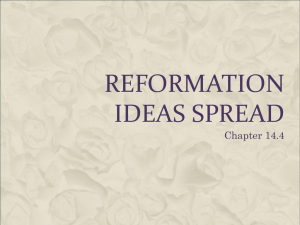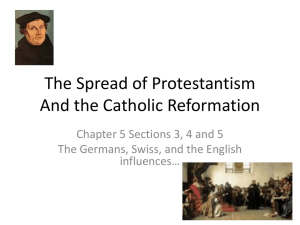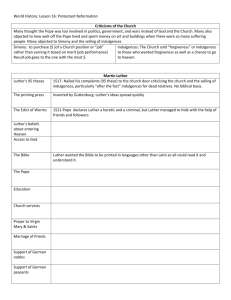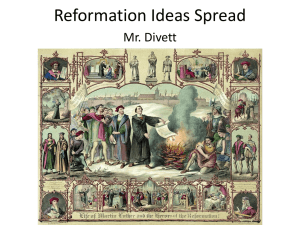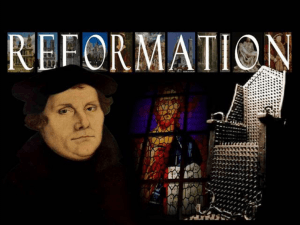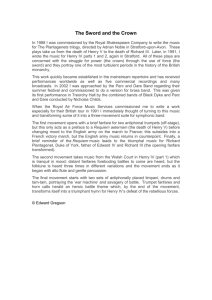yr 8 revision booklet - The British School of Bahrain
advertisement
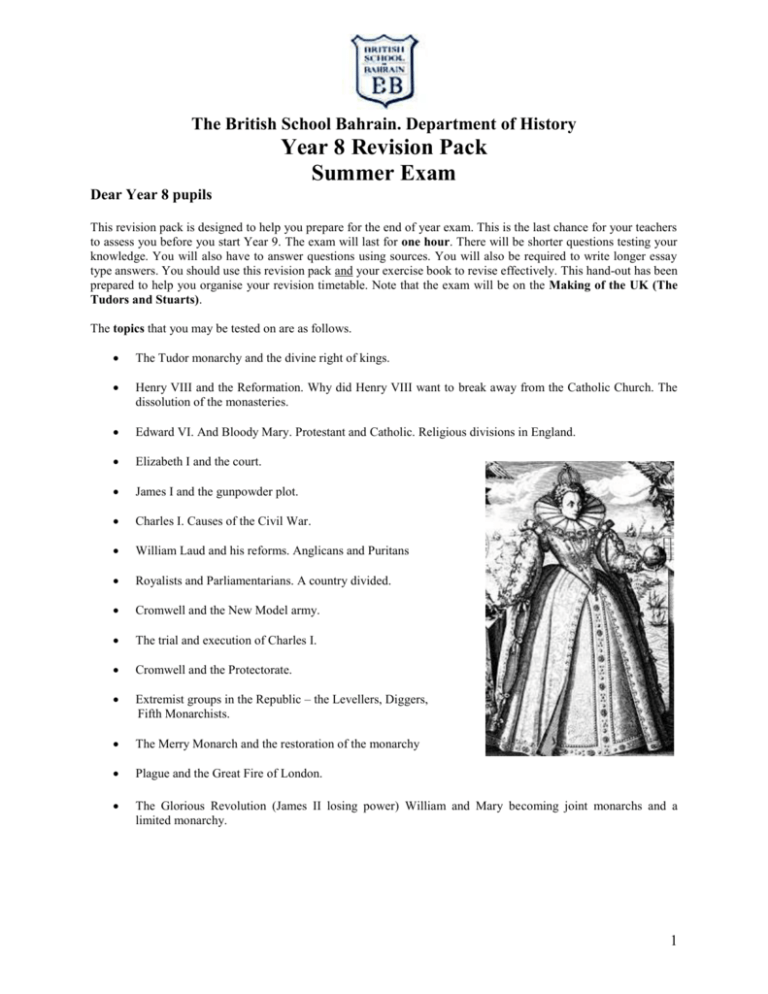
The British School Bahrain. Department of History Year 8 Revision Pack Summer Exam Dear Year 8 pupils This revision pack is designed to help you prepare for the end of year exam. This is the last chance for your teachers to assess you before you start Year 9. The exam will last for one hour. There will be shorter questions testing your knowledge. You will also have to answer questions using sources. You will also be required to write longer essay type answers. You should use this revision pack and your exercise book to revise effectively. This hand-out has been prepared to help you organise your revision timetable. Note that the exam will be on the Making of the UK (The Tudors and Stuarts). The topics that you may be tested on are as follows. The Tudor monarchy and the divine right of kings. Henry VIII and the Reformation. Why did Henry VIII want to break away from the Catholic Church. The dissolution of the monasteries. Edward VI. And Bloody Mary. Protestant and Catholic. Religious divisions in England. Elizabeth I and the court. James I and the gunpowder plot. Charles I. Causes of the Civil War. William Laud and his reforms. Anglicans and Puritans Royalists and Parliamentarians. A country divided. Cromwell and the New Model army. The trial and execution of Charles I. Cromwell and the Protectorate. Extremist groups in the Republic – the Levellers, Diggers, Fifth Monarchists. The Merry Monarch and the restoration of the monarchy Plague and the Great Fire of London. The Glorious Revolution (James II losing power) William and Mary becoming joint monarchs and a limited monarchy. 1 To revise effectively you need to make sure that you follow a few basic rules. Revise in a quiet place where there are no distractions. Turn off the television and radio. Revise in concentrated bursts of between 20 to 30 minutes. This will be more beneficial than sitting in front of the television for an hour with a book on your lap. Just reading is not ideal. Make notes as you read. Use bullet points and flow diagrams to help you remember important information. Write out key questions and then write out the main points that answer that question. For example Why did Henry VIII want to break away from the Catholic church? Some people find using different colours helpful as a way to revise. Discuss topics with a friend or parent and test each other. Try teaching someone a topic. This is a good way to learn something. Some people like to record information and then play back it back to themselves. Find out which way works for you. But doing nothing and then glancing at your book the night before the exam is not good and you will not do as well as you could have if only you had tried. The internet can also be a useful revision tool. http://www.schoolhistory.co.uk/year8links/ This is a very good web site designed for school pupils. You will find all kinds of revision exercises, quizzes and links to other useful websites. This can be very helpful to you and you should make the most of this resource. http://www.historylearningsite.co.uk This website has sections on the Tudors and the Stuarts but it is text heavy and designed for general readers, not children. You can also ask Mr Bannister for help if you need it at historyaid@gmail.com Set yourself targets for each revision session. For example you may decide to study the topic of the Gunpowder Plot. Don’t try and cover everything in one go. Your teachers and parents can only offer you advice. They cannot force you to revise. You have to be mature enough to take responsibility for your own actions. Remember this revision pack is a guide. It can not cover in detail a whole year’s worth of work. Use it with your exercise book. Work Hard & Good luck!!! 2 The Tudor monarchy and the divine right of kings The Tudors ruled from 1485-1603. Tudor was their family name and this period of English history is known as the Tudor period. The Tudor monarchs were Henry VII 1485-1509 Henry VIII 1509-1547 Edward VI 1547-1553 Mary 1553-58 Elizabeth I 1558-1603 The word monarch just means king or queen. The Tudors believed in the divine right of kings. This means The monarch is chosen by God and all power should rest with them. To go against the monarch is to go against God and is a sin as well as a crime. No one apart from God is above the monarch. It is the duty of all subjects to humbly obey the monarch in all things. Parliament is there only to advise the king when he wants it to. Henry VIII He is one of the most famous of the Tudor kings. He became king in 1509 when his father, Henry VII died of old age. Henry was famous for his large size and powerful personality. He was highly intelligent and a great sportsman in his youth. He is most famous for his complicated love life and starting the Reformation in England and Wales. Henry had six wives. They were:Catherine of Aragon Anne Boleyn Jane Seymour Anne of Cleves Catherine Howard Catherine Parr produced one daughter, Mary produced one daughter, Elizabeth produced one son, Edward no children no children no children divorced beheaded for adultery died in childbirth divorced beheaded for adultery survived The King’s great Matter By 1527 Henry wanted to divorce his first wife Catherine of Aragon. This was because of a number of reasons. Henry and Catherine had not produced a son. This was a disaster for Henry who worried that if he died without an heir England would have a civil war and the Tudor dynasty would be over. By 1527 Catherine was too old to have any more children. Henry was in love with the younger Anne Boleyn, one of Catherine’s ladies in waiting. Henry wanted to marry her and have a son with her. Henry was convinced that God had cursed his marriage to Catherine of Aragon. This was because it says in the Bible that a man should not marry his brother’s widow and Catherine had been briefly married to Henry’s older brother Prince Arthur who had died before Henry became king. The only person who had the power to give Henry a divorce so he could legally marry Anne Boleyn was the Pope. His name was Clement VII. 3 The Pope refused to give Henry VIII the divorce he wanted for a number of reasons. Firstly, Catherine’s nephew was the King of Spain, Charles V. He was the most powerful king in Europe and the Pope did not want to offend him. Charles did not want Henry to divorce his aunt as this would bring shame on his family. He had soldiers in Rome and the Pope was too frightened to upset him. Secondly, a previous pope had given Henry VIII special permission to marry Catherine of Aragon. To say now that the marriage was wrong would be to admit that a previous Pope had made a mistake. Pope Clement VII did not want to do this because Protestants were already attacking the Pope and saying that they were making lots of mistakes. The popes claimed that as head of the Catholic Church they represented God on earth and could not make mistakes. Therefore the Pope delayed and delayed and Henry did not get his divorce. In 1532 Anne Boleyn got pregnant. Now Henry only had a few months to get his divorce and marry Anne before the baby was born. If Henry and Anne were not married by the time the baby was born then it would be illegitimate and could not be become king. Helped by two of his advisors Thomas Cromwell and Thomas Cranmer Henry decided to break away from the Catholic Church. He passed a number of laws to form the Church of England. Henry VIII, was the Head of this new church, not the pope. As head of his own church Henry VIII gave himself a divorce and was able to marry Anne Boleyn. This was very unpopular with many English people. Laws were passed to make it a crime to criticise the king or what he had done. Some leading Catholics such as Sir Thomas More and Bishop John Fisher were executed for refusing to accept the Royal Supremacy. Despite replacing the pope Henry did not change the religion of his new church. In most ways Henry remained a traditional Catholic. He thought the Protestants were wrong on many issues. In fact he also had Protestants killed who disagreed with him. The Reformation The Reformation started in 1517 in Germany. It was started by a monk called Martin Luther. He was unhappy with many things about the Catholic Church and wanted it to reform itself. This is why the movement he started was called the Reformation. He also protested about the Catholic Church and he and his followers were called Protestants. Luther was unhappy about The Catholic Church was too rich and powerful. Luther thought that wealthy bishops were more interested in money and power and did not care about religion or Christianity. He hated the way that the Church taught that you could buy forgiveness from sin by buying an indulgence. An indulgence was a piece of paper that said you were forgiven for your sins and would not spend time in Purgatory. Luther said this was just a con to make money. Luther believed the Pope was wrong to do this and thought that the Pope could make mistakes. He did not feel the Pope had the right to be in charge of the whole Church. He felt the local king or prince should head the Church in his kingdom. Luther was unhappy that the Bible was only in Latin. He said this meant ordinary people could not understand what was in it and could be cheated by the priests who could make stuff up. Nowhere in the Bible does it talk about Purgatory. Luther wanted the Bible translated into German, English, French etc. 4 Luther’s ideas spread particularly in northern Europe. Soon Europe was divided between Protestants and Catholics. Both sides hated and mistrusted the other. There were wars fought between them. Each side was convinced the other side was evil. A common punishment that each side carried out was to burn people at the stake. Thousands of people from both sides were burnt as heretics. A heretic is someone who does not follow the ‘true’ religion. Why did Henry VIII break away from the Catholic Church? We have already seen that Henry broke away from the Church so he could give himself a divorce but this was not the only reason. TWO other reasons were POWER and MONEY POWER: As Head of the Church of England Henry VII had more power than any previous kings had had over religious matters. Henry now had the power to tell people what they should believe. He also had the power to choose all the bishops and control all church land and property. MONEY: Henry VII was also able to take the wealth of the Church in England and use it for his own purposes such as fighting wars and building his palaces. The Dissolution of the Monasteries Henry VIII decided to close down the monasteries of England and Wales. Monasteries were communities of monks and nuns who lived lives of prayer cut off from the ordinary world. Some monasteries were very wealthy and owned lots of land. Henry wanted their wealth. But he could not admit this in public. Helped by Thomas Cromwell, who was a Protestant, inspectors were sent out to find excuses to close the monasteries down. These were put into a Black Book or Comperta which detailed all the sins that the monks were committing like getting drunk, gambling and living immoral lives. This was the public reason why the monasteries were closed down. Henry took the land from the monasteries and sold it to raise money to spend on himself and his wars against Scotland and France. Many rich people bought land and benefitted from the dissolution. Henry made millions of pounds from the sale of the monasteries. Religion divides the Tudors Henry VII’s children all became monarchs and had different religious views. Edward VI was a strong Protestant. Encouraged by his advisors he made England into a much more Protestant country. Churches were made plainer. Statues and pictures, which the Protestants hated, were destroyed. Church services were in English, not Latin. Edward died at 15 and had no children so the crown went to his older half sister, Mary. Mary Tudor was a strong Catholic. She tried to turn back the religious changes of her father and half brother. England became Catholic again and rejoined the Catholic Church. Churches were redecorated. Mary was nicknamed Bloody Mary by Protestants because she had hundreds of Protestants burned to death. She thought this was necessary to destroy Protestantism in England. One of her most famous victims was Thomas Cranmer who had been her father and brother’s Arch Bishop of Canterbury. Elizabeth I was a moderate Protestant. She was quite happy for people to believe what they wanted as long as outwardly they conformed to her religious views. She made England a Protestant country but kept some Catholic elements such a singing hymns in church and kneeling to pray. She also kept bishops as this gave her 5 control. Most people were happy with her Religious Settlement and the modern Church of England is very much down to her policies. PURITANS and CATHOLICS Not everyone was happy with Elizabeth’s religious reforms. The PURITANS were extreme Protestants who felt Elizabeth’s Church of England was too Catholic. They wanted a Protestant Church that was 100% Protestant and based on the Bible. They looked to Protestant churches in Switzerland as an example. They hated bishops as they said they were Catholic. Puritans called themselves the Godly and tried to live very strict lives. They were against sins such as gambling, singing, dancing, drinking too much alcohol or anything that they felt was un Christian. They wore simple plain clothes as they thought bright colours, feathers and jewels were sinful. The Puritans were a minority but they were powerful and some of them were well educated and rich. They were to cause a lot of trouble for Charles I. The CATHOLICS were also a minority by the end of Elizabeth’s reign. They wanted England to return to the Catholic Church. Some of them tried to assassinate Elizabeth I and replace her with her Catholic cousin Mary Queen of Scots. All these plots failed. MARY QUEEN OF SCOTS had been Queen of Scotland but had been forced to flee by some of her Protestant subjects because she was a Catholic. They kept her son, James VI, and raised him as a Protestant. Mary fled to England where she was imprisoned by Elizabeth who did not trust her and worried Catholics would try to make her queen in Elizabeth’s place. In 1586 after over twenty years as a prisoner Mary was executed for treason. Her execution did not go smoothly. The executioner taking THREE blows to cut off her head. As a result Elizabeth became more and more suspicious of Catholics. Catholic priests were hunted down and executed. Catholics were fined large fines if they did not go to the Protestant churches. Some Catholics hoped that a foreign Catholic country like Spain or France might invade and restore Catholicism. The Spanish Armada 1588 One of the most important events in Elizabeth’s reign was the Spanish Armada. This was when Philip II of Spain decided to invade and conquer England and force England to become a Catholic country again. A huge fleet or armada of ships left Spain and sailed up the English Channel. The plan was to pick up a huge Spanish army from France and then invade England. However the English lit beacons along the coast to warn that the Spanish were coming. Sir Francis Drake, an English sea captain led the smaller but quicker English ships out to attack the Spanish ships. When the Spanish ships anchored at night near France to await the Spanish soldiers the English sent fire ships into the Spanish fleet. The Spanish ships scattered in panic. Then a huge storm blew up and the Spanish ships were forced to sail around the north of Scotland and Ireland. Many were sunk in the storm or shipwrecked. It was a great victory for the English as the Spanish were the most powerful country at this time. Elizabeth became very popular with the English. God seemed to be on England’s side. Elizabeth became known as Gloriana. She was careful about her image. She wanted to impress. She wore the most gorgeous and expensive dresses. Her court was designed to radiate power and wealth. All pictures had to show her as young and beautiful. Elizabeth never married, claiming she was married to England. She encouraged poets and playwrights. Noblemen competed to impress her. This was also the time of William Shakespeare. When she died in 1603 the Tudor age ended with her. 6 THE STUARTS The Stuarts were the royal dynasty that came after the Tudors. They were Scottish so they were kings of England and Scotland. The Stuarts also believed very strongly in the divine right of kings. This was going to cause problems and eventually led to the English Civil War starting in 1642. The Stuart monarchs were James I Charles I No monarch Charles II James II William and Mary Anne 1603-1625 1625-1649 (executed) 1649-60 Known as the Interregnum or the Republic 1660-1685 The Merry Monarch 1685-88 (lost power in the Glorious Revolution) 1688-1702 (given limited powers by Parliament) 1702-1714 James I and the gunpowder plot James I was the first Stuart King of England and Scotland. In Scotland he is known as James VI as Scotland had had five previous kings called James. James was the son of Mary Queen of Scots who he never knew. James I was a Protestant. Some Catholics decided to assassinate James I and all the leading Protestant Lords and Members of Parliament by blowing it up with gunpowder on the 6 November 1605. This is known as the gunpowder plot. There is some historical debate about whether there was a real plot or the whole thing was a set up by Cecil James I’s Protestant chief minister. You should look at the notes you were given on this plot in more detail. http://www.gunpowder-plot.org/ is a useful website to investigate. http://www.historylearningsite.co.uk/gunpowder_plot_of_1605.htm is also useful. Whether the plot was real or not, it failed and Guy Fawkes was arrested and tortured. All the plotters were arrested or killed. People became even more suspicious of Catholics after the plot and laws were passed that made it illegal for Catholics to go to university, hold government jobs or become Members of parliament. These anti catholic laws continued for hundreds of years. They were only got rid of in Victorian times. THE ENGLISH CIVIL WAR This is a huge topic and I am not going to write down all the information you need here. You should look at the worksheets that you were given in class and that you should have stuck into your exercise books. In particular make sure you know why the English Civil war started. Think about long and short term causes. What were the triggers? Remember there are faults on both sides. What did Charles I do that made things worse? What did Parliament do that made things worse? Think about the religious problems between Charles I, William Laud and the Puritans. Think also about the challenge to the idea of divine right of kings by some MP’s such as John Pym and Oliver Cromwell. 7 When you study the actual civil war itself focus on how the war affected everyday life. You will not be tested on all the battles. Be aware of who tended to support which side. The king Parliament The nobles Catholics The Catholic Irish The north and southwest Merchants and craftsmen Puritans Protestant Scots the south and midlands You should be aware of why the Parliament won. What strengths did they have that proved decisive? Skilled generals such as Oliver Cromwell A well trained and well equipped army. The New Model Army that really believed in what they were fighting for. Control of London and the richest and most populated parts of the country. Look at the execution of Charles I. Why was he executed? What arguments were used to justify executing a monarch? What impact did Charles I’s execution have in England? Look at some of the strange groups that sprang up at this time when the world seemed upside down Who were The Levellers The Diggers The Fifth Monarchists What did they want? CROMWELL and the INTERREGNUM Look at Oliver Cromwell. What kind of man was he? What did he do when he was in power? Why are there such different views about him? How was England governed when it was under Oliver Cromwell’s rule? The Restoration The Restoration was in 1660 when Charles II was invited back to the throne. Why did this happen? What was the Restoration Settlement and what did it say? The GLORIOUS REVOLUTION 1688 Why did James II lose his throne after only three years? Why were William and Mary asked to become joint King and Queen? What did the Bill of Rights say and how did it limit the power of the monarch? What is a constitutional monarch (given powers to rule- limited powers) and how does it differ from an absolute monarch (having all the power – divine right of kings)? Why the Glorious Revolution is considered important today? 8



